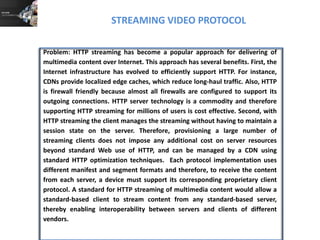Streaming Video Protocol
•Download as PPTX, PDF•
0 likes•274 views
Report
Share
Report
Share

Recommended
Recommended
More Related Content
What's hot
What's hot (8)
Similar to Streaming Video Protocol
The main problem is to avoid the complexity of retrieving the video content without streaming problem in multi network clients. The proposed work is to improve Collaboration among streaming contents on server resources in order to improve the network performance. Implementing network collaboration on a content delivery scenario, with a strong reduction of data transferred via servers. Audio and video files are transmitted in blocks to clients through the peer using the Network Coding Equivalent Content Distribution scheme. The objective of the system is to tolerate out-of-order arrival of blocks in the stream and is resilient to transmission losses of an arbitrary number of intermediate blocks, without affecting the verifiability of remaining blocks in the stream. To formulate the joint rate control and packet scheduling problem as an integer program where the objective is to minimize a cost function of the expected video distortion. Suggestions of cost functions are proposed in order to provide service differentiation and address fairness among users.Simulation Study of Video Streaming in Multi-Hop Network

Simulation Study of Video Streaming in Multi-Hop NetworkInternational Journal of Engineering Inventions www.ijeijournal.com
Similar to Streaming Video Protocol (20)
Transcoding & Streaming System for Media Companies

Transcoding & Streaming System for Media Companies
Multiscreen OTT Platform with Social Media Layer for OEMS

Multiscreen OTT Platform with Social Media Layer for OEMS
Implementing a Caching Scheme for Media Streaming in a Proxy Server

Implementing a Caching Scheme for Media Streaming in a Proxy Server
Cgmm presentation on distributed multimedia systems

Cgmm presentation on distributed multimedia systems
A NOVEL ADAPTIVE CACHING MECHANISM FOR VIDEO ON DEMAND SYSTEM OVER WIRELESS M...

A NOVEL ADAPTIVE CACHING MECHANISM FOR VIDEO ON DEMAND SYSTEM OVER WIRELESS M...
Simulation Study of Video Streaming in Multi-Hop Network

Simulation Study of Video Streaming in Multi-Hop Network
Building Cloud-ready Video Transcoding System for Content Delivery Networks (...

Building Cloud-ready Video Transcoding System for Content Delivery Networks (...
IRJET- Protected Adaptive Bitrate Streaming using HTTP Live Streaming and...

IRJET- Protected Adaptive Bitrate Streaming using HTTP Live Streaming and...
More from Arumai Technologies, Inc.
More from Arumai Technologies, Inc. (11)
Peer to Peer System in an OTT Platform Environment

Peer to Peer System in an OTT Platform Environment
System and method for intelligent decoding of pixels and macroblocks

System and method for intelligent decoding of pixels and macroblocks
Streaming Video Protocol
- 1. STREAMING VIDEO PROTOCOL Problem: HTTP streaming has become a popular approach for delivering of multimedia content over Internet. This approach has several benefits. First, the Internet infrastructure has evolved to efficiently support HTTP. For instance, CDNs provide localized edge caches, which reduce long-haul traffic. Also, HTTP is firewall friendly because almost all firewalls are configured to support its outgoing connections. HTTP server technology is a commodity and therefore supporting HTTP streaming for millions of users is cost effective. Second, with HTTP streaming the client manages the streaming without having to maintain a session state on the server. Therefore, provisioning a large number of streaming clients does not impose any additional cost on server resources beyond standard Web use of HTTP, and can be managed by a CDN using standard HTTP optimization techniques. Each protocol implementation uses different manifest and segment formats and therefore, to receive the content from each server, a device must support its corresponding proprietary client protocol. A standard for HTTP streaming of multimedia content would allow a standard-based client to stream content from any standard-based server, thereby enabling interoperability between servers and clients of different vendors.
- 2. Solution: In Arumai’s proprietary system: (i) multimedia content is captured and stored and delivered on an HTTP server and is delivered using HTTP. The content exists on the server in two parts: Media Presentation Description (MPD), which describes a manifest of the available content, its various alternatives, their URL addresses, and other characteristics; and segments, which contain the actual multimedia bit streams in the form of chunks, in single or multiple files; (ii) To play the content, the Arumai client first obtains the MPD. The MPD can be delivered using HTTP, email, thumb drive, broadcast, or other transports. By parsing the MPD, the Arumai client learns about the program timing, media-content availability, media types, resolutions, minimum and maximum bandwidths, and the existence of various encoded alternatives of multimedia components, accessibility features and required digital rights management (DRM), media-component locations on the network, and other content characteristics. Using this information, the Arumai client selects the appropriate encoded alternative and starts streaming the content by fetching the segments using HTTP GET requests; (iii) After appropriate buffering to allow for network throughput variations, the client continues fetching the subsequent segments and also monitors the network bandwidth fluctuations. Depending on its measurements, the client decides how to adapt to the available bandwidth (“transfer rates”) by fetching segments of different alternatives (with lower or higher bitrates) to maintain an adequate buffer. STREAMING VIDEO PROTOCOL (cont’d)
